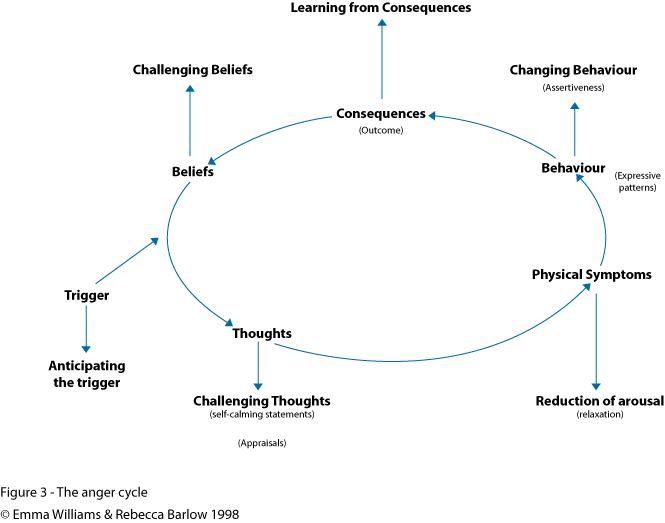Anger Management Strategy: Record the Episode
To begin the management of anger, both counsellor and client require an understanding of the client’s expressive patterns. This can be achieved by encouraging clients to complete an Anger Episode Record. This is a record of each trigger, appraisal, experience, expressive pattern and outcome the client encounters during an established time period.
Trigger
The target for my anger was:
The situation surrounding my anger was:Appraisal
The thought I had about the trigger was:
Experience
The intensity of my anger was (mark a cross on the scale)
0–5–10
(Mild–moderate–extreme)
Expressive patterns
I engaged in the following behaviour during this anger episode:
- Aversive verbalisations (yelling, arguing, threatening etc)
- Physical aggression (kicking, punching, throwing something etc)
- Passive retaliation (doing something deliberately harmful etc)
- Avoidance (escaping through TV or listening to music etc)
- Substance use (drinking a beer, taking an aspirin etc)
Outcome (positive)
List the positive short-term outcomes:
List the positive long-term outcomes:Outcome (negative)
List the negative short-term outcomes:
List the negative long-term outcomes:
The sample template (above) is an example of how a client might record this information. Recording information in this way fosters self-reflection and promotes personal awareness. Additionally, this information can act as a foundation on which cognitive approaches can be launched.
The anger episode model, illustrates the linear process from the experience of a trigger through to the final outcome. The cycle of anger presented below (image), demonstrates how this linear process is embedded within a continuous cycle of learning.

Our role as counsellors is to effectively thwart the momentum of this learning cycle by assisting clients to modify their response at one or more of the key points within the cycle. Through the completion of the anger episode record (strategy 1), it is anticipated that clients will have an enhanced awareness of their personal triggers, appraisals and expressive patterns. Awareness, of course, will do little to alter behaviour if clients are not encouraged to engage in corresponding action. It is therefore essential that any increase in awareness be coupled with appropriate strategies for initiating desired change.


Hello, I have been searching fruitlessly for an example of Breakwell’s 1997 five stage anger/assault cycle. Can you help?